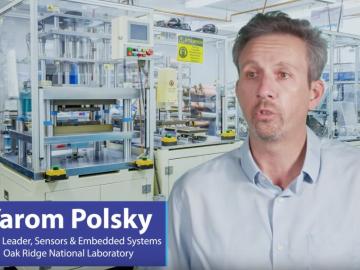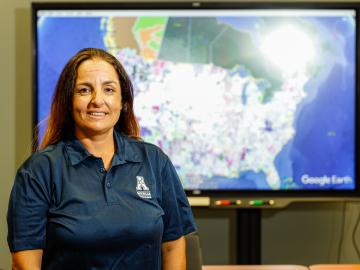
Filter News
Area of Research
- (-) Energy Science (93)
- (-) Fusion Energy (17)
- (-) National Security (16)
- (-) Supercomputing (71)
- Advanced Manufacturing (4)
- Biology and Environment (63)
- Biology and Soft Matter (1)
- Computational Biology (1)
- Computational Engineering (1)
- Computer Science (5)
- Electricity and Smart Grid (3)
- Energy Frontier Research Centers (1)
- Functional Materials for Energy (1)
- Fusion and Fission (29)
- Isotope Development and Production (1)
- Isotopes (5)
- Materials (109)
- Materials for Computing (14)
- Mathematics (1)
- Neutron Science (125)
- Nuclear Science and Technology (27)
- Nuclear Systems Modeling, Simulation and Validation (1)
- Quantum information Science (9)
- Sensors and Controls (1)
News Topics
- (-) Advanced Reactors (15)
- (-) Clean Water (8)
- (-) Fusion (17)
- (-) Grid (45)
- (-) Mercury (3)
- (-) Nanotechnology (15)
- (-) Neutron Science (22)
- (-) Physics (9)
- (-) Quantum Science (27)
- (-) Space Exploration (6)
- 3-D Printing/Advanced Manufacturing (84)
- Artificial Intelligence (50)
- Big Data (30)
- Bioenergy (31)
- Biology (22)
- Biomedical (22)
- Biotechnology (7)
- Buildings (39)
- Chemical Sciences (16)
- Composites (17)
- Computer Science (117)
- Coronavirus (27)
- Critical Materials (12)
- Cybersecurity (28)
- Energy Storage (74)
- Environment (73)
- Exascale Computing (27)
- Fossil Energy (2)
- Frontier (32)
- High-Performance Computing (46)
- Hydropower (3)
- Isotopes (2)
- Machine Learning (28)
- Materials (47)
- Materials Science (43)
- Mathematics (4)
- Microelectronics (1)
- Microscopy (14)
- Molten Salt (1)
- National Security (38)
- Nuclear Energy (24)
- Partnerships (16)
- Polymers (13)
- Quantum Computing (20)
- Security (18)
- Simulation (18)
- Software (1)
- Statistics (1)
- Summit (44)
- Transportation (72)
Media Contacts

Using the Titan supercomputer and the Spallation Neutron Source at the Department of Energy’s Oak Ridge National Laboratory, scientists have created the most accurate 3D model yet of an intrinsically disordered protein, revealing the ensemble of its atomic-level structures.

The National Alliance for Water Innovation, a partnership of the Department of Energy’s Oak Ridge National Laboratory, other national labs, university and private sector partners, has been awarded a five-year, $100 million Energy-Water Desalination Hub by DOE to address water security issues in the United States.

Isabelle Snyder calls faults as she sees them, whether it’s modeling operations for the nation’s power grid or officiating at the US Open Tennis Championships.

Using additive manufacturing, scientists experimenting with tungsten at Oak Ridge National Laboratory hope to unlock new potential of the high-performance heat-transferring material used to protect components from the plasma inside a fusion reactor. Fusion requires hydrogen isotopes to reach millions of degrees.

Using the Titan supercomputer at Oak Ridge National Laboratory, a team of astrophysicists created a set of galactic wind simulations of the highest resolution ever performed. The simulations will allow researchers to gather and interpret more accurate, detailed data that elucidates how galactic winds affect the formation and evolution of galaxies.

A new method developed at Oak Ridge National Laboratory improves the energy efficiency of a desalination process known as solar-thermal evaporation.

Sometimes solutions to the biggest problems can be found in the smallest details. The work of biochemist Alex Johs at Oak Ridge National Laboratory bears this out, as he focuses on understanding protein structures and molecular interactions to resolve complex global problems like the spread of mercury pollution in waterways and the food supply.

OAK RIDGE, Tenn., May 7, 2019—Energy Secretary Rick Perry, Congressman Chuck Fleischmann and lab officials today broke ground on a multipurpose research facility that will provide state-of-the-art laboratory space

In a step toward advancing small modular nuclear reactor designs, scientists at Oak Ridge National Laboratory have run reactor simulations on ORNL supercomputer Summit with greater-than-expected computational efficiency.

Scientists at Oak Ridge National Laboratory have developed a low-cost, printed, flexible sensor that can wrap around power cables to precisely monitor electrical loads from household appliances to support grid operations.


